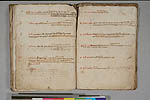 A
book of memorials and anniversaries of the Monastery of San Pedro
de Cardeña from 13th century Spain, near Burgos, with an entry
in a martyrology. A
book of memorials and anniversaries of the Monastery of San Pedro
de Cardeña from 13th century Spain, near Burgos, with an entry
in a martyrology.
|
| Plimpton MS 084: A martyrology of Usuard
and Rule of Benedict from France, around 1500 |
 The
first page of the martyrology showing December 24th and 25th. The
first page of the martyrology showing December 24th and 25th. |
 A
page from the martyrology showing the 15th and 16th of September and
the phases of the moon. A
page from the martyrology showing the 15th and 16th of September and
the phases of the moon. |
 The
opening of the Rule of Benedict. The
opening of the Rule of Benedict. |
In medieval monasteries, a meeting called chapter took place daily after
the office of Prime or after the morning mass. A monk was assigned to
read a chapter from the Rule (that of Benedict if the community
was Benedictine; that of Augustine if it was Augustinian, and so forth)
, or if it was a feast day, a special reading for that day. Next,
a member of the community (monk or nun) read the names of saints to be
commemorated the next day in the martyrology, a compendium listing
for each day the names of saints, the places in which they were commemorated,
and sometimes a summary of their deeds. The reader announced the phase
of the moon and recited the names of deceased monks and patrons of the
monastery recorded in the necrology .
Dates in the martyrology and necrology employ the Roman calendrical system
of kalends, nones, and ides. Books used in chapter were composites including
the Rule, martyrology, and necrology as well as other texts that vary
from manuscript to manuscript. The necrology included the names of monks
in the immediate community, of those in other affiliated communities,
and of powerful friends of the monastery such as aristocratic donors.
An eleventh-century Cluniac customary that provides formulas for the necrology
entries of various social groups (kings, dukes, countesses, bishops, monks,
etc.) states that nothing specific need be written for servants who have
died, except perhaps for their names.
 A
necrology from a nunnery in 15th century Germany, showing the
addition of commemorations over a long period. A
necrology from a nunnery in 15th century Germany, showing the
addition of commemorations over a long period. |
After the readings in chapter, the assignments to various monks of chants
and readings for the office were announced; the assignments were referred
to in some monastic customaries as the "brevis." At the end
of chapter, monks could publicly accuse other monks of misdeeds, whereupon
the wrongdoers would beg pardon or refute the accusation. The community
would agree upon a just penalty in accordance with the gravity of the
deed, sometimes resulting in immediate corporal punishment.
| Hispanic Society of America, MS HC 411/840:
A necrology copied in Spain ca. 1536 for the use of the Comendadores
de Santiago Mayor y de Santa Eufemia: |
 Added
entry for Maria Gutierez de Nogales, "famula dei." Added
entry for Maria Gutierez de Nogales, "famula dei." |
 Text
page. Text
page. |
| An Office of the Dead, commissioned
for the Confraternity of St. Christopher, from late 16th century Catalonia: |
 f.
2: Prayers for the dead. f.
2: Prayers for the dead. |
 f.
7v: Option of masculine or feminine forms: in black, "famuli
tui confratris nostri" and in red "famule tue confratrisse
nostre." f.
7v: Option of masculine or feminine forms: in black, "famuli
tui confratris nostri" and in red "famule tue confratrisse
nostre." |
|



